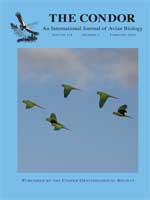In Booms, T. L., S. L. Talbot, G. K. Sage, B. J. McCaffery, K. G. McCracken, and P. F. Schempf, 2011, Nest-site fidelity and dispersal of Gyrfalcons estimated by noninvasive genetic sampling, Condor 113:768-778, the following table was inadvertently omitted. The editorial staff of the Condor regrets this oversight.
TABLE 3.
Pairwise comparison of FST and RSTvalues from Gyrfalcons sampled in three study areas in Yukon Delta National Wildlife Refuge, Alaska, 2003–2007. Significant values following correction for multiple comparisons indicated by asterisksa.

In Miller, M. J., M. J. Lelevier, E. Bermingham, J. T. Klicka, P. Escalante, and K. Winker, 2011, Phylogeography of the Rufous-tailed Hummingbird (Amazilia tzacatl), Condor 113:806–816, the coding of points in the figure and the key in figure legend were not properly coordinated. For proper coordination the legend should read
FIGURE 2. (A) Distribution of specimens of Amazilia tzacatl collected for this study. Colors represent mtDNA clades recovered from that location; broken circles represent sites with two clades recovered; see Fig. 3. 1, Veracruz, Mexico; 2, Tabasco, Mexico; 3, Toledo, Belize; 4, Atlantida, Honduras (note that the point on the map is situated about 200 km too far to the west); 5, La Luz, Nicaragua; 6, Guanacaste, Costa Rica; 7, Isla Colón, Panama; 8, Bocas del Toro mainland, Panama (multiple sites); 9, Isla Escudo de Veraguas, Panama; 10, central Panama; 11, Chiriquí lowlands, Panama (multiple sites); 12, Chiriquí foothills, Panama; unnumbered, Santa Fé, Vergauas, Panama; 13, Isla Coiba, Panama; 14, Azuero Peninsula, Panama; 15, border of Panamá and Darién provinces, Panama; 16, eastern Darién, Panama; 17, Pacific Ecuador; see Appendix for site details. (B) Minimum-spanning tree of ND2 sequences from Amazilia tzacatl. The population from Isla Escudo, originally described as a species, is circled in blue. Black dots indicate haplotypes unrecovered in our tree. This topology is congruent with the results of a Bayesian phylogenetic analysis (not shown). See Appendix for population codes.





